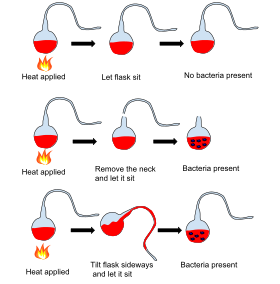Swan neck flask
A swan neck flask, also known as a gooseneck flask, is a flask with a particular shape of tube leading into it. A test tube or other vessel may also have a "swan neck". The swan neck significantly slows down the motion of air through the tube, and particles in the air, such as bacteria, become trapped on moisture on its inner surfaces. As a result, sterile liquid in the vessel itself remains sterile as long as the liquid does not contact the contaminated liquid in the tube. Louis Pasteur developed and used this apparatus in 1859 to prove that particles in the air (germ theory), rather than the air itself (spontaneous generation), led to fermentation.[1][2][3]

Bottle en col de cygne (Gooseneck bottle) used by Louis Pasteur

Louis Pasteur's spontaneous generation experiment illustrates the fact that the spoilage of liquid was caused by particles in the air rather than the air itself. These experiments were important pieces of evidence supporting the idea of germ theory of disease.
See also
References
- Pelczar, Michael J; Chan, E.C.SS.; Krieg, Noel R. (2010). Microbiology:Application Based Approach. Tata McGraw-Hill Education. p. 5. ISBN 9780070151475.
- Ashutosh, Kar (2007). Pharmaceutical Microbiology. New Age International. p. 5. ISBN 9788122420623.
- "Pasteur's "col de cygnet" (1859)". www.immunology.org. British Society for Immunology. Retrieved 2019-08-11.
This article is issued from Wikipedia. The text is licensed under Creative Commons - Attribution - Sharealike. Additional terms may apply for the media files.